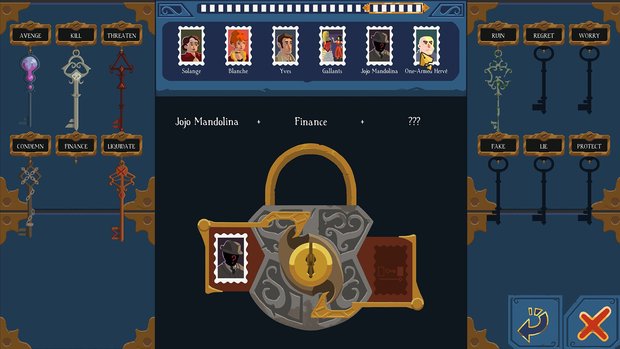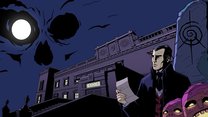Chronique des Silencieux review

- 1 Comment
Stylish but wordy 1970s French deduction mystery marred by faulty translation
Note: Since time of writing, a patch has been released that significantly updates the game with a brand new hint system and major changes to interrogations, leads and testimonies. This review is based solely on the launch version of the game before those improvements were implemented.
Solving crimes and mysteries isn’t always about finding and analyzing physical evidence. While picking up and investigating items certainly lends itself perfectly for adventure games, there’s another aspect just as important: questioning suspects. I’ve always loved pumping characters for information on a variety of topics in point-and-click classics like Gabriel Knight: Sins of the Fathers and The Dagger of Amon Ra. But you often had to take the offered information at face value in these games, and rarely had a real gameplay option to verify its veracity.
French developer Pierre Feuille Studio thought it was time to change that, taking inspiration from games like Papers, Please and Ace Attorney to bring us Chronique des Silencieux (roughly translated as “Chronicle of the Silencers”). Its main gameplay concept involves questioning suspects, comparing their statements with information found on (often hidden) documents, compiling a hypothesis about their true motivations, and then confronting them with the discrepancies. It could have been loads of fun from an investigative and deductive point of view, if not for several graphical glitches and an English translation that certainly isn’t up to snuff. For a game that relies very much on analyzing text, that’s one heck of a problem.
The game’s title suggests something majestic about it, something historic, but actually it’s a reference to crime and violence. A silencer can be screwed onto the barrel of a gun to muffle the sound of the shot. In this game, it’s also a reference to people keeping silent and hiding the truth, which matters greatly in a story reminiscing about World War II and resistance fighters.

The main character whom you will assist in uncovering those truths is Eugène Faury, a young lad who starts out traveling by train to a colorful isometric version of Bordeaux, France, in May 1965. The game begins with an elaborate prologue, teaching you the gameplay ropes through a couple of automatic tutorials while introducing us to the major characters, followed by two full-fledged chapters taking the story into the next decade.
The prologue starts with a posthumous letter from Eugène’s mom, sending him to visit his uncle Flavio. You will often find documents like this throughout the game, some handwritten, others typed. Some will be handed to you automatically by NPCs through the course of the narrative, while others you will have to actively snoop around for in coat pockets and desk drawers. You can zoom in for a better read, but you can’t trigger a plain text version of the handwritten documents, but fortunately the fonts used are legible enough on their own.
Upon his arrival, Eugène finds his uncle working as a “concierge” in a distinguished “gallantery” (pretty much a brothel). Eugène can interact with the girls working there (no, not in that way!), as well as their “madame,” the house chef, the girls’ private teacher, and an inspector for the local police who is conducting an investigation for which he needs Eugène’s help.

You can move Eugène directly with WASD or the arrow keys, or you can click on the screen wherever you want him to go. You control the camera separately by moving your mouse cursor towards the edges of the screen. There’s lots of animated detail in the portrayal of the cast and their mannerisms, such as impatient tapping of feet, beard and head scratching, arms changing positions, hand waving and finger pointing, which really brings the characters to life. They are designed in a recognizable French and Belgian comic book art style (think Tintin and Blake & Mortimer), with appropriately colorful 1970s outfits.
Hotspots appear as floating icons, which even cast a shadow on the ground, but they only show up when Eugène is close enough to them or the person they belong to, so exploration is definitely required. However, don’t get too close or they will disappear in a graphical glitch because they can’t occupy the same space as Eugène. The hotspot icons can be question marks (to take a closer look at something), double text balloons (to question important characters), eyes (to make small talk with extra characters), and footsteps (to indicate an exit).
You will often have to navigate your way through the hand-drawn city of Bordeaux (and later the neighboring town of Nérac) to find your next destination. Often when I moved the camera further down a street and clicked the spot where Eugène needed to go (for instance the front door of a building), he literally vanished. The game still reacted to him as if he was there, with hotspot icons popping up when he passed someone, for example, and the screen changed to the inside of the building as soon as “invisible” Eugène walked through the door I clicked on. Sometimes he would reappear when I moved the camera around a bit, but it was all very glitchy.
Chronique des Silencieux is a very dialogue-heavy game. Displayed text can be set to either the original French or English, and you can choose for the text to appear immediately or in typewriter style. The latter uses the most appropriate speed I’ve ever encountered in adventure games; usually it’s either too slow or too fast for my taste. You can still click to make all text appear right away when you’ve chosen typewriter style, but both settings lack an auto-advance, so you always still need to click to move on to the next part of the dialogue. And you’ll be clicking a lot! Carelessly click away the final part of a dialogue, however, and Eugène will start moving to wherever your cursor happens to be at that moment, confusing it for a walk command. Yet another bug in the system…
The dialogues are only voiced during the (few) cutscenes, and then only in French. The voice actors are sublime, though very low in volume compared to the music. As much as I like listening to the French language, I wish I could understand it better, but even I could tell where the English subtitling wasn’t up to par. The unvoiced dialogues also contain many strange words or weird grammatical fabrications, and more than once it was obvious the game could’ve done with extra proofreading. On the game’s Steam forum, the developers acknowledge problems with their translator and promise they’re working on fixing the issue, so future updates will hopefully result in improved writing.
The music in Chronique des Silencieux is very lively, with acoustic guitars, drums, xylophones and lots of other instruments nicely capturing France of the period. Cinema soundtracks of those eras are the prime inspiration, combining classical music with jazz and pop, with occasional nods to Ennio Morricone; after all, our main character Eugène is part Italian.

As a first introduction, “how to play” directions for moving Eugène around are displayed like graffiti painted on the city pavement, which I thought was a nice touch. A real step-by-step tutorial is launched when Eugène is given his first task of comparing a person’s statement with a written document. Instructions pop up on-screen, waiting for you to click on the indicated buttons, guiding you through the necessary process. This is where the main concept behind the game is explained: as an amateur sleuth, it’s your job to find discrepancies or connections between different accounts, find out who’s lying and what the real truth is.
And that’s where, theoretically, the fun should really start. You can question all NPCs about other characters and specific topics, which you can choose from a list of thumbnail-like pictures. These interrogations provide a transcript of the conversations, organized per topic. You can then hold each document you have found next to this transcript to check for inconsistencies between what’s been written and what’s been said, connecting the contradictions with a piece of red string and thumbtacks so well-known from many a TV detective show. But sometimes it’s not an actual contradiction you’re looking for, but a connection between two statements, which can be very confusing when it occurs. You have to figure out on your own what it is exactly that the game wants you to find.
Since that’s not very apparent, I resorted to lots of trial and error. I was constantly guessing, going over the documents and testimonies again and again, because I always seemed to be missing the necessary knowledge about what the solution was supposed to be. As is often the case with classic inventory puzzles in other games, in hindsight the answer is usually apparent. The difficulty of Chronique des Silencieux lies in the fact that there are lots of characters, lots of topics, long conversations, and many documents, all of which you need to peruse to find that one shared detail between them that will progress the story. Thankfully you have unlimited tries to link pieces of information, and when an attempt fails, that line in the transcript will be scratched out when you try to select the same piece of info to try again.

At several points throughout the game, important characters will lock themselves in their rooms, feeling you’re getting too close to the truth. You need to come up with several hypotheses before you can unlock the door and confront them with your discoveries. While questioning someone, you can unlock new topics as well as a number of “verbs.” When you form a hypothesis about a particular person’s true motivation, you can use these verbs to link two characters together (for instance, “One-Armed Hergé threatened Madame Solange”). This is visually represented as a padlock, where you put the characters’ profile pictures on each side and then use a particular verb, graphically represented by a key, to try to unlock it. If you succeed, your hypothesis is correct and you can continue your line of interrogation.
First, however, you’ll need to discover every character’s story elements – by talking to them or discovering useful information in hidden documents – to have any chance of making the right assumptions for your hypotheses. Thankfully, the game offers a list of those story elements and crosses them out when you’ve found all their details, at least making you aware there’s nothing left to find. Here too, though, a translation from French that looks like it would even have been better had they just run it through Google Translate adds extra difficulty for English gamers that could have easily been prevented.
There’s a hint system coupled to these story elements, where you can ask your police inspector friend Yves Maleski for advice, except it’s not always helpful. Often you’ll already be aware of the information, and you’re just having trouble locating the correct pieces of text to connect in the huge volume available to you; the inspector will never point these out, so it remains a game not of classic pixel hunting, but fact hunting instead. Other times Yves says he needs more information before he can give advice, meaning you haven’t yet found the right documents or testimonies needed for that particular connection, but you won’t get any clues as to WHERE to find them. His advice is often too subtle, too abstract to be really useful, and often there aren’t even any more hints available when you could really use one.

While I didn’t have that much trouble finding all the details for those story elements, compiling the right hypotheses turned out to be the most gargantuan task. A couple of them were easy, but most I only figured out through lots of experimenting; I had discovered what was going on, but I had some trouble translating this into the padlock options. One lock I really opened by accident: My reasoning was totally different but the combination of characters/topics and verb worked anyway, and the explanation totally surprised me. Yet another one needed an assumption I never even thought of, and I had to resort to a walkthrough to discover it. (And I hate using walkthroughs…) Once again, thankfully, you have unlimited tries here, and the elements you already tried to combine but weren’t successful get grayed out along the way.
Even then, after finishing with your hypotheses you need to confront the character in question and make them spill the beans. They’ll try to talk themselves out of your accusations, and then it’s back to the statements and documents to find the inconsistencies disproving their claims, courtroom-style. The first time I had to do this, I frustratedly quit the game halfway through because I had no idea what I was doing, and I realized I was just guessing and not finding the right solutions at all. When I returned with a clearer head, I forced myself to be more strategic about my choices, but even then success was hit or miss.
The difference from the previous sequences is that here you DON’T get unlimited tries. After one or two attempts, Eugène will say it’s too risky to keep guessing and Yves – who always magically shows up for these things – will suddenly take over and automatically mention the correct discrepancy. This always felt like a slap in the face for me, as if the game finally had enough of my muddling around and almost literally said, “Okay, you’re too stupid for this, let me take over.” You’ll still be able to finish the game this way, but at the end of each chapter you get a report card showing how many hints you asked for, and how many confrontational attempts you failed, which really hurts when you’re usually quite the perfectionist gamer.
At least there’s a compelling, complex narrative to uncover in Chronique des Silencieux, which shows the love and skill the developers have for storytelling. While the prologue only features a simple police investigation trying to link the brothel with Bordeaux’s criminal elements, the other chapters delve deep into the Second World War, the French Resistance groups, spies, codenames, and family secrets. The aforementioned teacher has an enigmatic history that his daughter wants to uncover, since he’s been acting strange. There’s clearly something on his mind related to his past, but instead of just coming out and sharing it, he wants you to investigate it as a real case. A bit weird, but okay. I was always eager to learn more as I went along, so it’s a shame it’s drowned out somewhat by all the extraneous information added to make for more difficult gameplay.
Final Verdict
You’d better have a good memory if you don’t want to spend hours reading through long blocks of text over and over again in Chronique des Silencieux, searching for that one piece of information that just might connect to or contradict another. The good news is that it’s all presented in a beautiful, evocative period setting with interesting characters, providing enough motivation to keep digging into their backgrounds. Sadly, the occasional graphical glitch, faulty translation and overly demanding deduction requirements make the gameplay experience much harder than it should be. Pierre Feuille Studio has the right idea and introduces a great concept for detective games, but they should have tested and polished it up further before releasing. To their credit, during my 14-hour playthrough they released several updates that gradually improved certain issues, making the third part of the game smoother than the first two. It still wasn’t perfect, but it’s moving in the right direction, so here’s hoping it will get there so more people can enjoy the intriguing elements lurking beneath the surface.
Hot take
Questioning and confronting suspects in Chronique des Silencieux can be very fun if you’re a patient reader willing to ignore the often faulty English translations and some technical issues to really appreciate this intricate detective story set in 1970s France.
Pros
- Beautiful comic book-style settings and characters
- Detailed story filled with World War II-related history
- Image-based interview format is a fun way to unlock topics and uncover more of the narrative
Cons
- Lots of vocabulary and grammatical mistakes in the English translation
- Not pixel hunting but fact hunting to scour long blocks of text
- Several graphical glitches
Johnny played Chronique des Silencieux on PC using a review code provided by the game’s publisher.











1 Comment
Want to join the discussion? Leave a comment as guest, sign in or register in our forums.
The developers have just released a major update, fixing several problems I mentioned in my review. You can read all about it on their Steam page: https://store.steampowered.com/news/app/2114300/view/4179980031217198088?snr=1_5_9_
Reply
Leave a comment